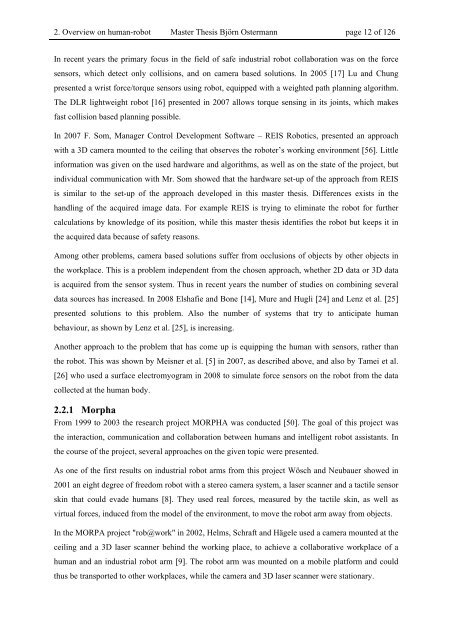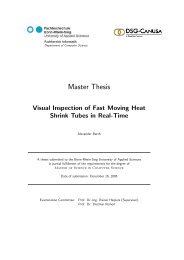Master Thesis - Hochschule Bonn-Rhein-Sieg
Master Thesis - Hochschule Bonn-Rhein-Sieg
Master Thesis - Hochschule Bonn-Rhein-Sieg
You also want an ePaper? Increase the reach of your titles
YUMPU automatically turns print PDFs into web optimized ePapers that Google loves.
2. Overview on human-robot <strong>Master</strong> <strong>Thesis</strong> Björn Ostermann page 12 of 126<br />
In recent years the primary focus in the field of safe industrial robot collaboration was on the force<br />
sensors, which detect only collisions, and on camera based solutions. In 2005 [17] Lu and Chung<br />
presented a wrist force/torque sensors using robot, equipped with a weighted path planning algorithm.<br />
The DLR lightweight robot [16] presented in 2007 allows torque sensing in its joints, which makes<br />
fast collision based planning possible.<br />
In 2007 F. Som, Manager Control Development Software – REIS Robotics, presented an approach<br />
with a 3D camera mounted to the ceiling that observes the roboter’s working environment [56]. Little<br />
information was given on the used hardware and algorithms, as well as on the state of the project, but<br />
individual communication with Mr. Som showed that the hardware set-up of the approach from REIS<br />
is similar to the set-up of the approach developed in this master thesis. Differences exists in the<br />
handling of the acquired image data. For example REIS is trying to eliminate the robot for further<br />
calculations by knowledge of its position, while this master thesis identifies the robot but keeps it in<br />
the acquired data because of safety reasons.<br />
Among other problems, camera based solutions suffer from occlusions of objects by other objects in<br />
the workplace. This is a problem independent from the chosen approach, whether 2D data or 3D data<br />
is acquired from the sensor system. Thus in recent years the number of studies on combining several<br />
data sources has increased. In 2008 Elshafie and Bone [14], Mure and Hugli [24] and Lenz et al. [25]<br />
presented solutions to this problem. Also the number of systems that try to anticipate human<br />
behaviour, as shown by Lenz et al. [25], is increasing.<br />
Another approach to the problem that has come up is equipping the human with sensors, rather than<br />
the robot. This was shown by Meisner et al. [5] in 2007, as described above, and also by Tamei et al.<br />
[26] who used a surface electromyogram in 2008 to simulate force sensors on the robot from the data<br />
collected at the human body.<br />
2.2.1 Morpha<br />
From 1999 to 2003 the research project MORPHA was conducted [50]. The goal of this project was<br />
the interaction, communication and collaboration between humans and intelligent robot assistants. In<br />
the course of the project, several approaches on the given topic were presented.<br />
As one of the first results on industrial robot arms from this project Wösch and Neubauer showed in<br />
2001 an eight degree of freedom robot with a stereo camera system, a laser scanner and a tactile sensor<br />
skin that could evade humans [8]. They used real forces, measured by the tactile skin, as well as<br />
virtual forces, induced from the model of the environment, to move the robot arm away from objects.<br />
In the MORPA project "rob@work" in 2002, Helms, Schraft and Hägele used a camera mounted at the<br />
ceiling and a 3D laser scanner behind the working place, to achieve a collaborative workplace of a<br />
human and an industrial robot arm [9]. The robot arm was mounted on a mobile platform and could<br />
thus be transported to other workplaces, while the camera and 3D laser scanner were stationary.














